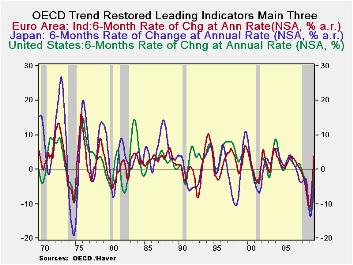 Global| Nov 06 2009
Global| Nov 06 2009Everybody Is Turning Higher Say OECD LEIs
Summary
In the OECD area everything is coming up roses. Some are more in bloom than others and some have more thorns than others but the OECD gave a very upbeat assessment to activity in the OECD areas. OECD leading indicators ... “point [...]

In the OECD area everything is coming up roses. Some are more
in bloom than others and some have more thorns than others but the OECD
gave a very upbeat assessment to activity in the OECD areas.
OECD leading indicators ... “point strongly to growth in
Italy, France, the United Kingdom and China, while tentative signals of
expansion have emerged in Canada and Germany," the OECD said. "A
recovery is clearly visible in the United States, Japan and all other
OECD economies and major non-OECD economies," it added.
The OECD indicators selected in the table above all show
strong (double digit) increases over the recent six months expressed as
annual rates of growth. Simple three-, six- and twelve-month growth
rates are positive across all these countries/groups with the exception
of 12 month growth in Japan (see top panel of the table above). The
OECD data are up-to-date though September.
Echoing this sentiment are the new industrial orders for
September released today by Germany that find orders on the growth path
for the seventh month in row. The problem for Germany is that now
domestic orders have dropped for the second month in a row. The two
month drop which amounts to a bit more than a 3% set back comes on the
heels of a 9.5% monthly rate super spike in domestic orders for July.
Still foreign orders continue to expand and Germany’s domestic orders
are not along for the ride.
The OECD data show us why German export orders are rising:
that export oriented economy exports goods globally and the whole OECD
area is having a nice snap back. But Germany is still an important
country in EMU, the largest economy there. Having the German domestic
factory sector so weak on top of previously-reported weakness in German
retail sales, is a clear warning sign to not get too carried away by
optimism.
The OECD area is snapping back from a very ugly recession. But
the recession was so ugly that the snap back can look strong but still
fail to bring growth to a strong enough point to spur a drop in
unemployment. That’s exactly what we seeing in the US. Despite a US MFG
sector that has been posting good results, increases in industrial
production and a rise to strong level for the MFG ISM, the US is not
seeing job growth. Europe is finding some growth deficiencies as well.
Today the UK got an unexpected visit from a higher PPI. The OECD area
is not strong enough to be abele to cope with any inflation signals
just yet. Let’s hope the UK PPI is just a rogue signal. Meanwhile, we
need enough economy strengthening to create job, income and spending
growth while allowing savings to make some headway as well. It’s a tall
order that we are falling short on despite the growth path endorsed by
the OECD.
| OECD Trend-restored leading Indicators | ||||
|---|---|---|---|---|
| Growth progression-SAAR | ||||
| 3Mos | 6Mos | 12mos | Yr-Ago | |
| OECD | 15.8% | 14.9% | 1.5% | -6.5% |
| OECD7 | 16.8% | 15.3% | 0.5% | -6.9% |
| OECD.Ezone | 16.9% | 16.6% | 4.0% | -7.9% |
| OECD.Japan | 13.1% | 10.9% | -4.7% | -4.5% |
| OECD US | 16.8% | 15.0% | -0.6% | -6.7% |
| Six month readings at 6-Mo Intervals: | ||||
| Recent six | 6Mo Ago | 12Mo Ago | 18MO Ago | |
| OECD | 14.9% | -10.3% | -10.5% | -2.3% |
| OECD7 | 15.3% | -12.3% | -10.7% | -3.0% |
| OECD.Eur | 16.6% | -7.3% | -12.3% | -3.3% |
| OECD.Japan | 10.9% | -18.1% | -9.2% | 0.4% |
| OECD US | 15.0% | -14.2% | -9.8% | -3.5% |
| Slowdowns indicated by BOLD RED | ||||
Robert Brusca
AuthorMore in Author Profile »Robert A. Brusca is Chief Economist of Fact and Opinion Economics, a consulting firm he founded in Manhattan. He has been an economist on Wall Street for over 25 years. He has visited central banking and large institutional clients in over 30 countries in his career as an economist. Mr. Brusca was a Divisional Research Chief at the Federal Reserve Bank of NY (Chief of the International Financial markets Division), a Fed Watcher at Irving Trust and Chief Economist at Nikko Securities International. He is widely quoted and appears in various media. Mr. Brusca holds an MA and Ph.D. in economics from Michigan State University and a BA in Economics from the University of Michigan. His research pursues his strong interests in non aligned policy economics as well as international economics. FAO Economics’ research targets investors to assist them in making better investment decisions in stocks, bonds and in a variety of international assets. The company does not manage money and has no conflicts in giving economic advice.






